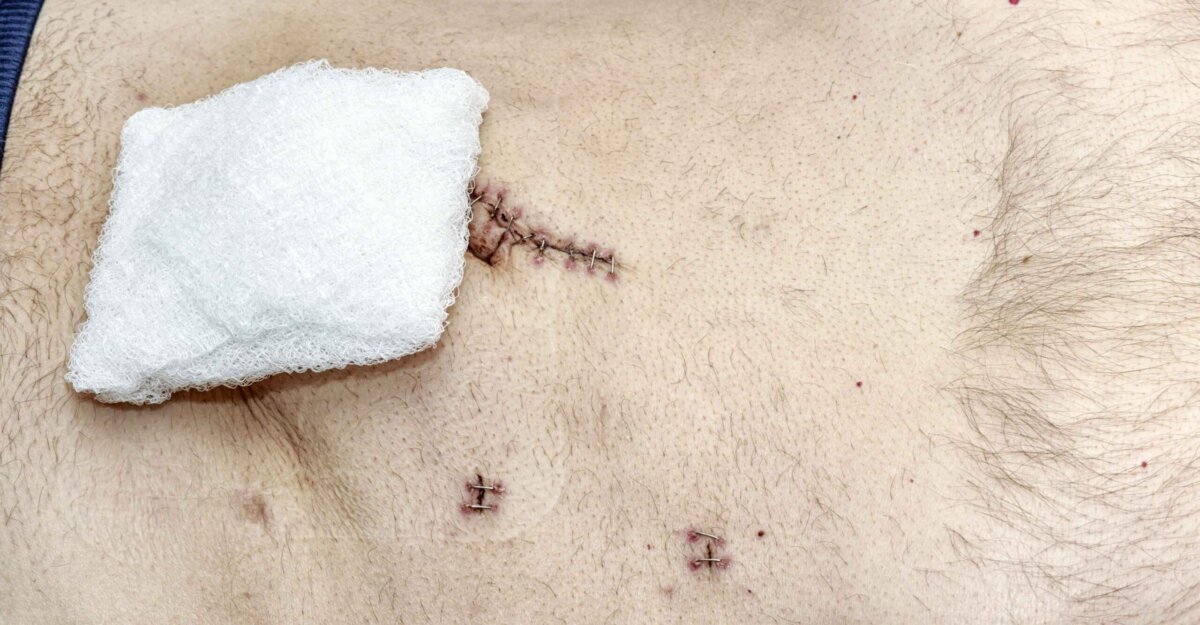Wound dehiscence occurs in up to 3.4% of patients who receive abdominopelvic surgeries, causing physical discomfort and delayed healing.
This condition is a significant postsurgical complication that can negatively impact a patient’s quality of life.
It occurs when a surgical incision fails to heal properly and the wound edges separate, leaving tissues and even internal organs vulnerable to complications. Let’s explore this postoperative complication in more detail.
Wound dehiscence defined
Wound dehiscence occurs when previously approximated wound edges separate. This is because of the failure of the progression of normal wound healing.
It can be a partial or complete separation of wound edges, specifically ones previously closed by primary intention. This condition most commonly happens in abdominal procedures, but it also occurs in postoperative load-bearing joints, such as the knee.
What causes dehiscence?
Dehiscence typically occurs within the first one to two weeks following surgery. Common causes include:
- Poor blood flow to the surgical wound
- Postoperative infection
- Significant inflammation in postsurgical tissues
- Poorly controlled glucose levels
- Smoking
- Increased abdominal pressure
- Malnutrition
- Previously radiated tissues
- Dehydration
- Use of glucocorticoids
- Increased tension on the closed incision
Patients with one or more of these conditions have a less-than-ideal environment for healing.
For example, a patient who is considered obese, has poorly controlled diabetes, and requires abdominal surgery, or an older, frail, chronically dehydrated patient with rheumatoid arthritis who requires cardiothoracic surgery would be at a higher risk.
How do you fix wound dehiscence?
Treating and correcting wound dehiscence depends on the severity and depth of the affected tissues. Superficial dehiscence is treated by managing any immediately modifiable causes. This includes:
- Instituting non-weight bearing status to a postoperative joint incision
- Managing inflammatory edema following hip surgery
- Using an abdominal binder following abdominal surgery (This is specific to any patient with a body mass index above normal.)
Deeper dehiscence is often treated by selecting an appropriate dressing based on the condition of the wound and the amount of drainage present. Changing dressings frequently allows the new surgical wound to heal by secondary intention.
Complete wound dehiscence occurs when all layers of skin and muscle reopen. This can expose internal tissues and organs and usually requires immediate surgical intervention.
Debridement of the devitalized tissue is usually part of the treatment plan when infection or tissue ischemia is a contributing factor. A smaller percentage of dehisced wounds have tertiary wound closure when the wound edges are surgically closed following a period of healing by secondary intention.T
Challenges and complications
Wound dehiscence, from minor to significant, poses challenges in postoperative care. It not only disrupts normal progression through the phases of healing, but it can prolong the healing process. Ultimately, it can also increase treatment costs for patients as well as the length of time they spend at medical facilities.
Identifying the cause of the skin disruption is another challenge. When clinicians determine a cause, an effective treatment plan can be put into place. However, if a primary cause isn’t determined, this newly open wound becomes at risk for infection which can require another surgical procedure.
Infection can lead to:
- The need for long-term antibiotics
- Worsening of dehiscence
- Prolonged healing times
- Further wound deterioration
The infection could also spread to underlying tissues, subcutaneous structures, and into bone, which can progress to an overall systemic infection that can threaten a patient’s limb or even their life.
Overwhelming infection in patients with chronic comorbidities or weakened immune systems can also be more difficult to treat. Before reaching the proliferation phase of healing, the infection must be addressed, which can be costly and time-consuming for these patients.
Evisceration is another complication in postoperative abdominal incisions. This normally occurs after complete wound dehiscence and the abdominal organs herniate into the wound opening.
Deeper abdominal dehiscence into the fascia would require an emergent operative procedure to prevent evisceration. If there are herniated organs in the wound bed, cover the wound with a sterile saline dressing until the patient can be taken to the operating room and the organs reduced back into the abdomen.
Extensive scarring can also create complications when deeper wounds heal by secondary intention. This can be bothersome for some patients depending on the severity and location. Deeper dehiscence can also place a patient at risk of developing a hernia because of the weakened areas of scar tissue.
How to prevent wound dehiscence
Educating patients is the most critical step in preventing wound dehiscence. It’s important to explain how following postoperative instructions, including activity, medication, and at-home care, promotes normal healing and reduces the risk of infection.
Encouraging patients to make certain lifestyle changes can help reduce the risk of dehiscence. This includes good nutrition and not smoking. Patients who reduce or quit smoking before surgery can optimize blood flow to the incision site. And patients with healthy, balanced diets rich in protein, vitamins, and minerals can improve the healing process.
For patients with diabetes, keeping their blood glucose levels within a healthy range is essential, as perioperative hyperglycemia can increase the risk of postoperative complications. It’s also important to instruct patients on recognizing and reporting any signs of incision problems to prevent the progression of potential issues.
As always, it’s better to prevent than to treat when it comes to wound and skin challenges. Although we know complications will sometimes happen, the goal is to minimize the effects.
Want to learn more about wound dehiscence? Explore WCEI's Skin and Wound Management courses, and take your expertise even further.
Get StartedWhat do you think?

